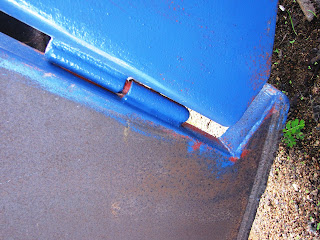A standard wylo2 has 10 portholes. 5 on each cabin-side. Eight of them are 6" (150mm) diameter and the two forepeak ones are 4" (100mm) diameter. They are small size for great strength in open ocean, unlikely to break open when slammed by a huge wave. The designed sizes are carefully proportioned to the boat and look pleasing to a discerning eye. They make up a fair portion of the boats character.
I'm going for simple fixed port lights, which will have some external lexan or perspex on sealant and galvanised through bolted. This is the most economical way to start off and there's little chance of an annoying drip or worse. Also there is no danger of dissimilar metals which could cause electrolytic corrosion.
(For ventilation I'm counter-acting the lack of opening ports with 3" high hatch coamings to stop deck wash, a large fore-hatch, sizeable opening skylight, 2 dorade boxes, canvas spray dodger on the main hatch etc)
Foreground is the galley port light. Next 2 are for the main saloon.
- The deck and cabin sides were fully welded up first.
- The portholes were marked/scribed on from the plans. 6" and 4" round templates with center hole.
- A small pilot hole is drilled at each portholes center
- Another template with 8 outer fastening bolt holes was made up.
- The 8 attachment bolt holes were center punched for each port (separate 4 inch port template also made).
- Then a cutting jig was created. It has a central pivot point on a slide clamp, attached to an arm with the oxy-acetylene torch on the end with small wheel.
- The pivot point goes into the center hole and the oxy torch then describes a nice arc just inside the 6" and 4" diameter scribed lines.
- Small angle grinder or wheel to trim up the edge to scribed lines.
- 1/4" attachment bolts holes were drilled out.
Other options are possible. Nick used his salvaged bronze portholes. Some rubber and small hose around bolts was used to isolate the steel from the bronze to stop electrolysis from occurring. Some of these are opening ports.
Some wylos have 1-2 opening ports at the forward end of the cabin/fore peak. This allows air to blow straight in there, but you could get some water/rain in there onto the bunk if not attentive.
I've seen a wylo with home-made stainless opening ports machined in a sugar mills workshop during the slow season.
As mentioned previously the aft bunk/stern opening port hole is a good optional extra if you have the time-budget. Tai Taki 2s transom port can be left open most of the time while on board. Its under the overhanging transom and is usually to leeward when on an anchor or swing mooring.
My transom port is 7" diameter, just astern of the quarter berth area. It's well above the static waterline (hopefully the careened waterline too). No bolt holes are drilled yet.. If i cant find a suitable old opening port hole, then the plan is to make an internal opening port with galvanised frame. If you are in a hurry to launch then it probably would be better to not have this port hole (as per the plans).
Another reason for fixed side ports. I met a yachty who owner-built a 50ft yacht with side opening ports. She was tied up to river piles. While the crew were away ashore the tide went out and the boat fell over downhill away from the piles, when the tide came back in the yacht filled up via the open ports and the hull was totally submerged. The yacht was salvaged, pain-stakingly repaired and sold.
As a result of this story I'm trying to confine anything that opens to above the extremely heeled careened waterline. I'm sure it's possible with a wylo2 as nearly all the hatches, dorade pipes etc are inboard around the center line. Omitting the port side lazarette hatch entirely could also make the hull inherently safer and faster-easier to build. I have a large lazarette hatch coaming already in place, its advantages are in port ventilation and easy access below. It will have to be kept dogged down at sea or when unattended in tidal ports.













































